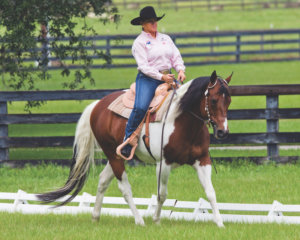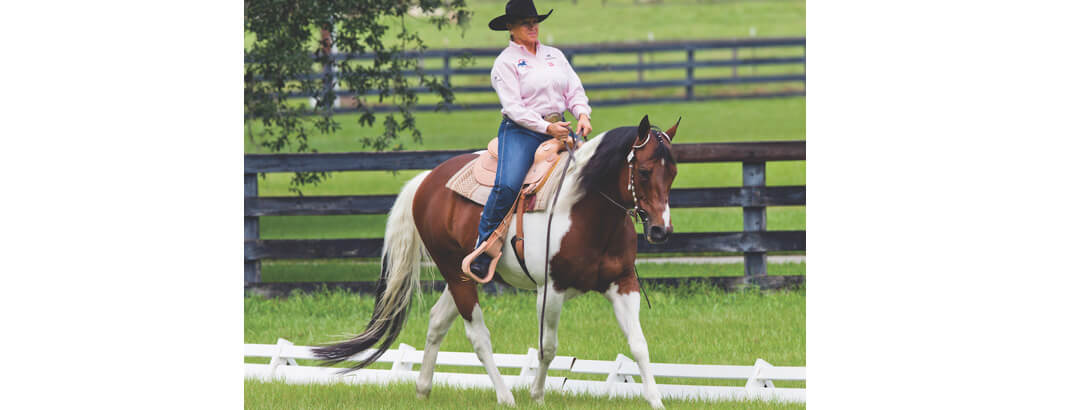A Closer Look at Tack
By Lynn Palm

Any time you get into a different discipline, it’s important to know what tack is allowed in competition. The smart rider researches ahead of time to learn all the rules about what tack is permitted (and what isn’t).
I recommend practicing at home with the tack you plan to use at the show. This is so important! Train at home with the bridles, bits, and saddles/pads that you use at a show. This allows you and your horse to be familiar with the tack and helps avoid unpleasant surprises on show day.
Most people have a nice show saddle that fits the horse and rider, but never use it unless they are at a show. Instead of using their “good” saddle at home to school and practice in, they may use a “working” saddle, but one of poor quality that does not fit the horse and rider. If you want to ride well, you have to have properly fitting tack for you and your horse. Properly fitting tack will allow you to have better balance in the saddle.
Bits are another topic. Some people will train at home with a milder bit and use a harsher bit at the show. I advise against this practice because it causes problems. When a horse goes to a show, he is in new and unfamiliar surroundings. A new place will always make a horse more sensitive. Using a more severe bit to get control of a horse who is more reactive at a show will only intensify the horse’s reactions.
Keep the same bit and use the mildest bit possible to promote relaxation. A relaxed mouth will always give you a more responsive horse.
The Western Dressage Association of America is only a few years old. The association’s rules can be found at their website, www.westerndressageassociation.org.
Please read all the tack and attire rules. Here’s a summary of the tack required.
Headstalls and Bits
Western headstalls are a must and a Western cavesson is optional. A Western cavesson (flat, rolled, braided, or plain, with an adjustable noseband), or pencil bosal with or without a get-down rope with space for two fingers placed between the cavesson and the jowl of the horse is allowed. No metal (except for the buckle on the cavesson), studs of any kind, or other substances can be used in conjunction with or as part of a Western cavesson.
Smooth snaffles, 3-piece smooth snaffles, or mullen mouthpiece bits are allowed. Use the snaffle for any level test and all ages of horses. Snaffles are ridden with two hands. Refer to website for acceptable mouthpieces.
A hackamore (bosal) is permitted on a horse of any age, and at any level. A hackamore includes a bosal, rounded in shape and constructed of braided rawhide or leather, and must have a flexible non-metallic core attached to a suitable headstall. No other material of any kind is to be used in conjunction with the bosal, (for example, steel, metal or chains). Bosals may be wrapped with smooth electrical tape to prevent rubbing.
Curb bits can be used on any age of horse and any level. They can be ridden with two hands. If you refer to the tack rules, you will find the specific sizes and types of bits that are legal. You should also review the section on illegal bits, so you don’t use the wrong one.
Saddles and Whips
Western saddles that are permitted include stock saddles, work saddles, Aussie, native or side saddle. Silver on saddles will not count over good working equipment. A horn on the saddle is not required, but Western style fenders are required. A breastplate and/or crupper may be used. Tapaderos are permitted except in equitation classes.
Whips are allowed no longer than 47.2″ including lash.
Be sure to peruse the website for more information on tack. And check out the section on illegal equipment, as it shows other miscellaneous Western tack that is not permitted.
With my accomplished horseman/saddle-maker husband, we have designed a Western Dressage saddle (www.lynnpalm.com under Boutique on the home page). It’s designed specifically for this new and fun competition.
I hope you truly enjoy this sport!
Published September 2018 Issue

The Northwest Horse Source is an independently owned and operated print and online magazine for horse owners and enthusiasts of all breeds and disciplines in the Pacific Northwest. Our contemporary editorial columns are predominantly written by experts in the region, covering the care, training, keeping and enjoyment of horses, with an eye to the specific concerns in our region.






